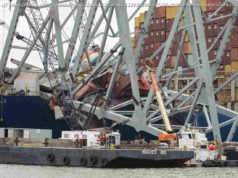Hurricane Maria slammed into Puerto Rico early Wednesday pounding the island with huge waves, massive rain, and lashing winds as the storm buzz-sawed its way through the mountainous island.
San Juan, Puerto Rico—Hurricane Maria slammed into Puerto Rico early Wednesday pounding the island with huge waves, massive rain, and lashing winds as the storm buzz-sawed its way through the mountainous island.
Hurricane Maria, now a Category 4 storm with sustained winds of 155 miles an hour, is the most powerful hurricane to hit Puerto Rico since a 1928 storm which killed more than 300 people. Maria could dump as much as 18 inches of rain on the island and is likely to trigger flash floods and mudslides. More flooding is likely to come in coastal areas hit by a storm surge predicted to be up to 9 feet accompanied by large and destructive waves.
Hours before the storm even made landfall, its winds knocked out power throughout the island whose electricity grid had already been hit hard as Hurricane Irma passed off Puerto Rico’s north coast two weeks ago. At the time, Irma knocked out power for more than 1 million Puerto Ricans. Many thousands never had power restored before Maria hit. The National Hurricane Center said Maria made landfall near the southeastern town of Yabucoa at 6:15 a.m. Wednesday with wind gusts of us to 113 miles an hour. The National Ocean Service also reported swelling ocean levels.
Before dawn Wednesday, Maria’s howling winds pelted San Juan with driving rain. The conditions knocked down street signs and decapitated streetlights in the historic old city in two.
Before hitting Puerto Rico, Hurricane Maria struck the island of St. Croix, one of the U. S. Virgin Islands which had been largely spared major damage when Hurricane Irma decimated its sister islands of St. John and St. Thomas two weeks ago.
The double whammy of Irma followed by Maria will add pressure on Puerto Rico’s strained finances. Both the island’s government and its state-owned public-power monopoly are under bankruptcy protection, after years of over borrowing and a decade of economic recession. Congress last year installed an oversight board to renegotiate roughly $73 billion in debt and coax business interests back to Puerto Rico.
The island’s economic woes have caused the government to slash its budget, cutting deeply into education and shutting schools. Puerto Rico’s downward spiral has led to a mass migration of residents to the U. S.
But with the fury of Maria looming over the island, the government Tuesday focused on saving lives. Officials tried hard to convince Puerto Ricans who were in harm’s way to seek refuge in government shelters. Arguments were blunt. Time and time again on the eve of the storm, Governor Ricardo Rosello told Puerto Ricans they were putting their lives at risk if they stayed in flood-prone areas or if they lived in flimsy houses which would be swept away by Maria’s fury.
“It’s not safe to be out on the streets, it’s not safe to be in a house with a zinc roof, or in a wooden house, or in a flood area,” Mr. Rosselló said at one news conference. “This is very serious. It’s the most dangerous storm in a century in Puerto Rico.”
Other officials repeated the same warning. “People in flood-prone areas must evacuate,” Hector Pesquera, the island’s top public-safety official warned on Monday. “If not, you will die.”
On the eve of the storm, news radio stations crackled with anxious warnings. San Juan residents lined up to put gas in their cars, stocked up on bottled water and desperately searched for power generators.
Workers labored Tuesday boarding up San Juan storefronts and then waited for the inevitable.
“It’s going to be ugly,” hotel worker Pedro Rivera said as he rushed home to finish the last of his hurricane preparations.
Like many other island residents, Mr. Rivera was bracing for a long period without electricity. Many areas in Puerto Rico haven’t had power since Hurricane Irma struck a glancing blow nearly two weeks ago.
“We think the lights will go out for months,” Mr. Rivera said. After watching Irma flatten neighboring islands, Mr. Rivera feared Hurricane Maria would bring the same destruction to Puerto Rico.
“I’m scared,” he said.
The eye of the Category 5 storm tore into Dominica Monday night with maximum sustained winds near 160 miles an hour, ripping away roofs, knocking out electricity and inundating streets and mountainsides with heavy rain.
Roosevelt Skerrit, Dominica’s Prime Minister lost his home and had to be rescued according to a post on his
Facebook
account. Mr. Skerrit wrote there were initial reports of widespread devastation on the island of 74,000 people.
The prime minister had posted no additional news by early afternoon Tuesday, and calls to the island were unsuccessful.
Maria was the strongest storm on record to hit Dominica, an island that relies heavily on agriculture, offshore banking and some tourism.
The island has been hard hit before. Tropical Storm Erika killed roughly 30 people there and left hundreds homeless in August 2015. In 1979, Category 3 Hurricane David killed an estimated 56 people on the island and left three out of four homes uninhabitable.
French Interior Minister
Gérard Collomb
said initial searches after the passage of the storm revealed limited damage on the island of Martinique, just south of Dominica.
Mr. Collomb said the storm had left 80,000 homes in neighboring Guadeloupe in the dark. The island’s prefecture said one person was killed by a falling tree, and two people were reported missing after a vessel capsized off the island of La Désirade.
Jean-Michel Jumez, a local French official, said the storm has caused minimal damage around Pointe-à-Pitre, the administrative center of Guadeloupe.
There is more concern about the islands of Marie-Galante and Les Saintes, which lie closer to Maria’s path to the south of Guadeloupe, and officials were still trying to establish contact with those islands, he said. Communication has been very difficult.”
—Anthony Harrup contributed to this article






